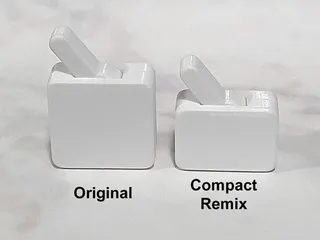3D Printer Tolerance - Gap Test
Description
PDFUpdate: I made a ‘Lite’ version that omits the .6 mm - 1.0 mm buttons (for those with printers that are well tuned), it uses ~½ the filament and prints in ~½ of the time. Here is the link:
https://www.printables.com/model/424091-3d-printer-tolerance-gap-test-lite-version.
-----
Technically, this design is a remix of a tolerance test by druppy - http://www.thingiverse.com/thing:1420023. I didn't know about the Ultimate Clearance Calibration Test by Energywave until when I started posting my design (I wasn't familiar with what the Re-mix button does or meant :/ ). It looks like Energywave and I both looked at druppy's design and figured out how to reduce the size and printing time by staggering the holes and reducing a lot of the excess base material. We also both designed in an additional brim at the base to help reduce the negative effects of curl-up/warping. Furthermore, we also both discovered that a chamfer at the bottom and top of the holes and pegs make the test more accurate because first layers always are somewhat sloppy. I put numbers on the tops of my pegs/plugs/buttons, so you can see what the gap is for each plug, because druppy had some on the excess base material that I removed.
Energywave's and my re-mix designs are fairly similar. One might be thinking that I copied Energywave. I assure you again that my design was finished before I even knew Energywave's design existed. I guess great minds think alike (if only I had one :) ).
HOWEVER, THERE IS A SIGNIFICANT DIFFERENCE between my design and Energywave's design. With my design, the tolerance gaps range from 0.1 mm to 1.0 mm IN DIAMETER. It appears that Energywave's gaps are 0.1 mm to 1.1 mm IN RADIUS. For example, in my design the difference between the inside diameter of the 1 mm hole and the outside diameter of the corresponding peg/plug/button is 1 mm (0.5 mm radius difference x 2). Energywave's 1 mm gap or difference is in the RADIUS, and it is actually a 2 mm difference in the inside/outside diameters. Either design is functional, you just need to be aware of how the gaps are being determined. Thus, Energywave's range of gaps is twice that of my design, but the sizing increments in my design are twice as fine.
With either design, you simply print the test, and push out the buttons (by hand), until you hit buttons that won't push out. You will know pretty quickly which buttons are fused in place -- they don't budge. It is fun to start with the widest gap and then work up to the smallest gap. So far, the best print tolerance that I have been able to print on my design is the 0.4 mm gap. 0.1, 0.2 & 0.3 mm are fused in place (see the photo). I would print this test at a high quality setting if you want to know your printer's limitations, or if you want to know the tolerances for a given design, print the test at the same resolution and settings that you plan on printing your design.
As a side note, even if one is unable to push out by hand a tighter button, you can still usually lightly tap out one or two of the tighter tolerance buttons using a mallet and some type of punch or rod that has a diameter smaller than that of the buttons. If you have a vise, just open the jaws a bit so that the gap between jaws is wide enough for the button to fall through, while the rest of the test piece is supported on top of the jaws. This method of removing partially fused parts works for many 3D designs when releasing them by hand is difficult.
Print Settings
Printer Brand:
Creality
Printer:
Ender 5
Rafts:
No
Supports:
No
Resolution:
0.12
Infill:
35%
Filament: Hatchbox PETG Black
Category: 3D Printing Tests
Tags
Model origin
The author marked this model as their own original creation. Imported from Thingiverse.




